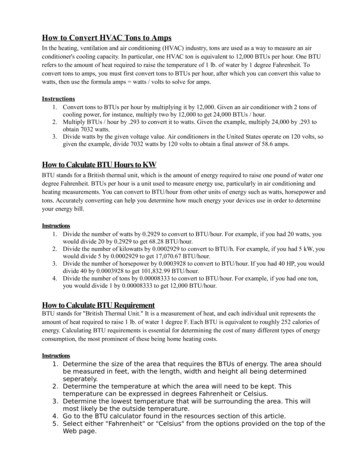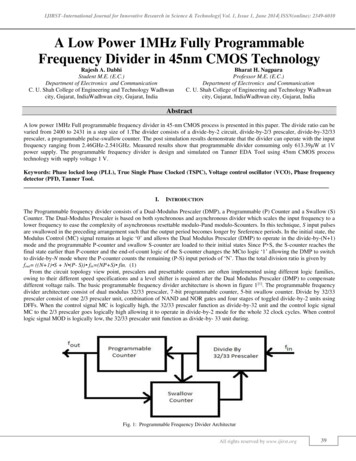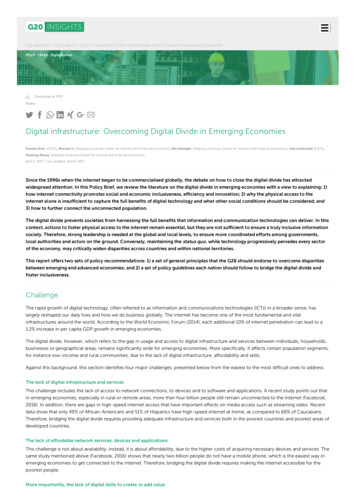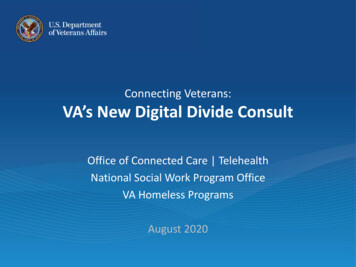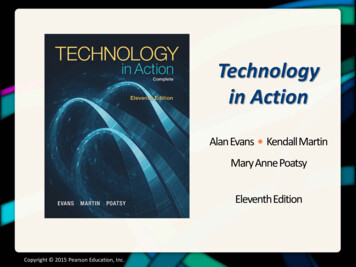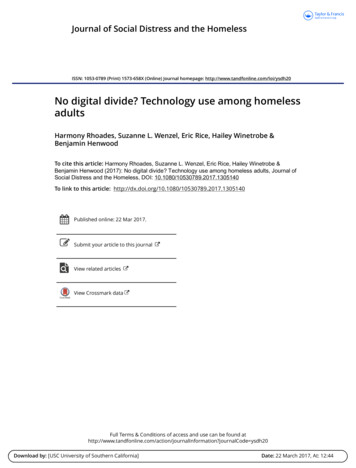
Transcription
Journal of Social Distress and the HomelessISSN: 1053-0789 (Print) 1573-658X (Online) Journal homepage: http://www.tandfonline.com/loi/ysdh20No digital divide? Technology use among homelessadultsHarmony Rhoades, Suzanne L. Wenzel, Eric Rice, Hailey Winetrobe &Benjamin HenwoodTo cite this article: Harmony Rhoades, Suzanne L. Wenzel, Eric Rice, Hailey Winetrobe &Benjamin Henwood (2017): No digital divide? Technology use among homeless adults, Journal ofSocial Distress and the Homeless, DOI: 10.1080/10530789.2017.1305140To link to this article: lished online: 22 Mar 2017.Submit your article to this journalView related articlesView Crossmark dataFull Terms & Conditions of access and use can be found tion?journalCode ysdh20Download by: [USC University of Southern California]Date: 22 March 2017, At: 12:44
JOURNAL OF SOCIAL DISTRESS AND THE HOMELESS, 0No digital divide? Technology use among homeless adultsHarmony Rhoades, Suzanne L. Wenzel, Eric Rice, Hailey Winetrobe and Benjamin HenwoodSuzanne Dworak-Peck School of Social Work, University of Southern California, Los Angeles, CA, USAABSTRACTARTICLE HISTORYHomeless adults experience increased risk of negative health outcomes, and technology-basedinterventions may provide an opportunity for improving health in this population. However,little is known about homeless adults’ technology access and use. Utilizing data from a studyof 421 homeless adults moving into PSH, this paper presents descriptive technology findings,and compares results to age-matched general population data. The vast majority (94%)currently owned a cell phone, although there was considerable past 3-month turnover inphones (56%) and phone numbers (55%). More than half currently owned a smartphone,and 86% of those used Android operating systems. Most (85%) used a cell phone daily, 76%used text messaging, and 51% accessed the Internet on their cell phone. One-third reportedno past 3-month Internet use. These findings suggest that digital technology may be afeasible means of disseminating health and wellness programs to this at-risk population,though important caveats are discussed.Received 5 January 2017Accepted 1 March 2017IntroductionHomeless persons experience greatly increased risk formany negative health and social outcomes (Fazel,Geddes, & Kushel, 2014; Hwang & Burns, 2014). Technology is an important resource that may improvehealth and wellbeing; however, technology accessmay be differentially distributed based on social andeconomic inequality (a phenomenon known as the“digital divide”; McAuley, 2014), which can excludethose at the greatest risk for negative health andother outcomes. This may be of increased importanceas technology-based interventions for health promotion rapidly proliferate (Okorodudu, Bosworth, &Corsino, 2015; Sawesi, Rashrash, Phalakornkule, Carpenter, & Jones, 2016; Silva, Rodrigues, de la TorreDíez, López-Coronado, & Saleem, 2015). The increasing ubiquity of digital technology could exacerbatemarginalization among those without access and mayworsen existing health disparities (McAuley, 2014).Because of transience and unstable living conditions, cell phones and Internet access can beespecially crucial for maintaining social and servicecontacts among homeless persons (Eyrich-Garg,2010; Rice, Lee, & Taitt, 2011). However, little previousresearch has examined technology use among homelessadults. Rice et al. (2011) demonstrated the prevalenceof cell phones among homeless youth, though researchwith homeless adults has found mixed rates of access(Eyrich-Garg, 2010; McInnes et al., 2014). A systematicreview by McInnes, Li, and Hogan (2013) found cellphone access among homeless populations variedCONTACT Suzanne L. Wenzelswenzel@usc.eduFisher Building, Los Angeles, CA 90089, USA 2017 Informa UK Limited, trading as Taylor & Francis GroupKEYWORDSHomelessness; technologyuse; cell phones; internetaccess; digital dividefrom 44 to 62% and Internet use estimates rangefrom 19 to 84%; these authors also noted the sparsebody of research on these topics.In order to develop technology-based interventionsfor homeless adults, we must first better identify patterns of use in this population. Toward this end, thisstudy presents descriptive information from a sampleof homeless adults about Internet and cell phone accessand use. We subsequently compare these results to datafrom an age-matched general population sample.MethodsRespondents were 421 homeless adults moving intopermanent supportive housing (PSH) in the LosAngeles or Long Beach, CA areas, and were referreddirectly from 26 housing/service provider agencies, orrecruited during building lease-up events. Given thenumber of agencies and individual staff membersinvolved in recruitment, it was not feasible to calculatean overall refusal rate; however, 93.4% of personsapproached at building lease-up events agreed to complete a study eligibility screener, and 89.5% of thosescreened were study eligible. Eligibility requirementswere age 39 , moving in without minor children, andability to complete interviews in English or Spanish.These participants were enrolled as part of a largerstudy of HIV risk behavior change over time in PSH;as such, the age and non-parenting requirementswere implemented to maximize our ability to detectchanges in HIV risk outcomes by minimizingSuzanne Dworak-Peck School of Social Work, University of Southern California, Montgomery Ross
2H. RHOADES ET AL.variability due to developmental life stage or currentparenting status. Interviews were conducted fromAugust 2014 to October 2015, occurred prior to orwithin 5 days of PSH move-in, and assessed a varietyof topics, including technology use. Participants wereTable 1. Demographic characteristics and technology useamong homeless adults.Transitioning to permanent supportive housing(n 421)%(n)/mean(SD)Limited torespondents ages50–64 only(n 261)Ourdata(%)Pewdata(%)aDemographic characteristicsAge54.4 (7.5)GenderMale71.5 (301)Female27.8 (117)Transwoman/transfemale3 (0.7)Race/ethnicityBlack56.0 (235)White24.3 (102)Latino/Hispanic10.5 (44)Multiracial5.0 (21)Other race/ethnicity4.3 (18)Completed high school77.0 (324)Monthly income594.0 (472.6)Military veteran30.4 (128)Most common place of stay (past 3 months)Shelter41.8 (176)Transitional living20.9 (88)Outside17.1 (72)Vehicle7.1 (30)Another location13.1 (55)Lifetime duration of literal6.0 (6.9)homelessness (years)Any literal homelessness in past 376.7 (323)monthsTechnology use in the past 3 monthsCurrently own a cell phone93.6 (394)9590Owned a cell phone in past 396.1 (407)months2 cell phones (among those with a55.8 (228)cell phone in the past 3 mo.)2 phones32.4 (132)3 phones13.3 (54)4 phones4.7 (19)5 phones5.7 (23)2 phone numbers (among those54.5 (223)with a cell phone in the past 3mo.)2 numbers33.4 (136)3 numbers12.0 (49)4 numbers4.4 (18)5 numbers4.9 (20)Currently own a smartphone58.0 (244)5958Smartphone operating system (among those with smartphones)Android85.6 (209)Apple7.0 (17)Other7.3 (18)Use cell phone daily85.0 (358)Use cell phone toSend/receive texts75.5 (318)7675Access the Internet51.1 (215)4945Listen to music50.4 (212)4826Download apps38.7 (163)3533Send/receive email38.2 (161)3843Internet useDaily39.0 (164)Less than daily28.5 (120)Never32.5 (137)3412Own a computer/tablet21.9 (92)aThese numbers come from publicly available general population data, aspublished by the Pew Research Center (Anderson, 2015; Duggan, 2013;Perrin & Duggan, 2015).paid 20. Study protocols were approved by theauthors’ University’s Institutional Review Board.Demographics included age, gender, race/ethnicity,education, and income. Place of stay questions wereadapted from prior research with homeless persons(Tsemberis, McHugo, Williams, Hanrahan, & Stefancic, 2007; Wenzel, 2009), and literal homelessnesswas defined as staying in temporary/emergency shelter,outside, abandoned building, garage or shed not meantfor living in, indoor public place, vehicle, or publictransportation (National Alliance to End Homelessness, 2012). Author-created items assessed cell phoneand other device ownership, including number ofdifferent phones and phone numbers in the past 3months. Measures regarding smartphones and cellphone usage activities were adapted/adopted from thePew Research Center (2013). Frequency of cell phoneand Internet use items were adapted from Rice et al.(2011).ResultsAs shown in Table 1, homeless adults in this study were54 years old on average, mostly male (72%), and predominantly Black (56%) or White (24%). Nearly onethird were military veterans, 77% completed highschool, and average income was 594/month. Mostcommon place of stay was temporary/emergency shelter (42%), followed by transitional living program(21%), and outdoors (17%). Average lifetime literalhomelessness duration was 6 years, and 77% reportedpast 3-month literal homelessness.The vast majority of respondents owned a cellphone currently (94%) or in the past 3 months(97%). Turnover in both phone ownership andphone numbers was high, with 56% of those with cellphones reporting 2 phones in the past 3 months(13% reported 3 phones; 5% 4 phones; 6% 5 phones)and 55% reporting 2 phone numbers (12% had 3phone numbers; 4% 4 numbers; 5% 5 phone numbers). More than half (58%) currently owned smartphones; 86% of smartphones used Android operatingsystems. Daily cell phone use was reported by 85%,and 76% reported text messaging in the past 3 months.Other common past 3-month phone activities includedInternet use (51%), listening to music (50%), downloading apps (38%), and email (38%). Daily Internetuse was reported by 39%, while 33% reported no past3-month Internet access. Twenty-two percent reportedpast 3-month tablet or computer ownership.Comparisons to general populationTable 1 also shows descriptive statistics for selectedvariables limited to respondents aged 50–64 yearsold. Variables included are those that could be directlycompared to publicly available data from the Pew
JOURNAL OF SOCIAL DISTRESS AND THE HOMELESSResearch Center for the same-age group (Anderson,2015; Duggan, 2013; Perrin & Duggan, 2015). Thesecomparisons show that our respondents report slightlyhigher rates of current cell phone ownership thansame-age persons in the general population, at 95%,compared to 90%. Rates of smartphone ownership(59 and 58%, respectively), text messaging (76 and75%), and downloading apps on cell phones (35 and33%) were remarkably similar between our respondents and same-age Pew Research Center respondents.Homeless respondents had slightly higher rates ofaccessing the Internet on cell phones (49 and 45%)and slightly lower rates of checking email on cellphones, at 38%, compared to 43% in the general population data. There was a larger gap between the groupsin listening to music on cell phones, at 48% in oursample and 26% in the general population.DiscussionLimitationsThese data come from a cohort of homeless adultsmoving into PSH and are therefore not necessarilyrepresentative of all homeless adults in Los Angeles.Although persons moving into PSH are some of themost vulnerable homeless adults (Henwood, Byrne, &Scriber, 2015), we do not know how technology usemeasured in this study might compare to homelesspersons not preparing to move into housing, nor howthe necessity of being connected to service providersin order to engage in the housing process may impacttechnology use (i.e. technology use may be differentamong those homeless persons who do not engagewith housing service providers in any way). Givenour study recruitment methods, we were also unableto accurately assess differences between persons whoagreed to be part of this study and those who refused.Further, these data came from Los Angeles, a dense,urban area that is home to the largest population ofhomeless persons in the U.S.A.; technology use inthis context may be different from that in rural orother urban settings. Finally, the current study sampleexcluded persons under the age of 39 and those movinginto PSH with minor children; developmental life stageand parenting may impact technology use in ways thatcannot be addressed with these data.ConclusionsNearly every homeless adult in this study had a cellphone; as such, technology access is unlikely to be amajor barrier to the dissemination of cell phonebased health interventions for this population. Combined with previous research identifying receptivenessto the use of cell phones for health interventionsamong homeless persons (Burda, Haack, Duarte, &3Alemi, 2012; McInnes et al., 2015), the high-prevalenceof cell phones found in this study suggests that technology-based programs may be promising methods forimproving health and wellness among homeless adults.However, such programs should take into account thehigh rate of turnover in both phones and phone numbers, which may complicate consistent technology useover time.Cell phone ownership in this study was higher thanthat found in previous research with homeless adults(Eyrich-Garg, 2010; McInnes et al., 2013, 2014),suggesting that the digital divide between homelessand housed adults has narrowed. Further, given similarrates of smartphone access in this population compared to the general population, smartphone applications may be a feasible option for technology-basedinterventions among homeless adults. Android operating systems were the most common; as such, providersand researchers interested in utilizing smartphonebased interventions with this population might consider targeting Android operating systems to ensurereaching the greatest number of persons.Homeless adults in this study reported low rates ofInternet access and limited ownership of computer ortablet devices. It is not unexpected that few respondents would own computers or tablets, given thatmost people were staying in emergency shelters or onthe street, where it is more difficult to maintain ownership of larger devices. However, given that computersand tablets may be better suited than phones for certaintasks requiring extensive typing or editing – such aswriting resumes and completing job applications –and Internet access can provide important informational and social support resources, housing programsmay consider focusing on providing device and Internet access, including free wireless Internet in PSHbuildings, and training in technology use for residents.The results presented here suggest that homelessadults are using cell phones in ways similar to the general population, indicating that technology-basedintervention programs are viable for this population.However, as providers and researchers seek to utilizetechnology-based interventions with homeless adults,it may be helpful to be mindful of the myriad intersecting vulnerabilities (e.g. physical/mental health conditions, cognitive deficiencies, trauma) that maycomplicate an individual’s ability to engage effectivelywith technology. In designing or delivering technology-based programs, providers and researchers mightconsider taking into account several potentialconcerns:(1) High turnover in phones/phone numbers mayimpact long-term connectivity, as well as createdifficulties for participants who may be forced tofrequently re-learn the basic functionality of newphones.
4H. RHOADES ET AL.(2) Homeless persons experience the onset of agingrelated physical health problems an average of 20years earlier than their housed counterparts(Brown et al., 2016), and many of these health problems (e.g. hearing, vision, and cognitive impairments) may impact their ability to use andunderstand new technology. As such, programsmay want to focus on simple designs and theincorporation of ongoing training and support tominimize technology use limitations related tophysical health and cognitive issues, particularlyas this population ages. There may additionallybe a need for cell phones and other digital devicesdesigned specifically for older adults experiencingvision or hearing impairment.(3) Smartphone programs may be most effective ifthey are available on Android operating systems,as those are most commonly used among thispopulation.(4) Providers and funders might consider focusingon improving Internet access, as this is one areawhere this population lags behind their housedcounterparts.Taking such steps may help ensure that technologybased programs are truly conferring the intendedbenefits for this vulnerable population of homelessadults.Eric Rice, PhD, is an associate professor in the USC SuzanneDworak-Peck School of Social Work. He is an expert insocial network theory and analysis, and the application ofsocial network methods to HIV prevention research. He iscommitted to community-based participatory research,and has worked closely with many community-based organizations on issues of HIV prevention for homeless youth andimpoverished families. He has served as an external reviewerfor Los Angeles County’s Office of AIDS Programs and Policy and has helmed multiple large-scale research projectswith homeless youth and high risk adolescents.Hailey Winetrobe, MPH, is the project manager on theNIDA-funded Transitions to Housing study in the USCSuzanne Dworak-Peck School of Social Work. Her researchinterests include homelessness, HIV risk and preventivebehaviors, and social networks. Hailey earned her Master’sin Public Health from the University of California LosAngeles and is a certified health education specialist.Benjamin Henwood, PhD, MSW, is a recognized expert inmental health and housing services research whose workconnects clinical interventions with social policy. He is aco-author of Housing First: Ending Homelessness, Transforming Systems, and Changing Lives published by OxfordUniversity Press, and his proposal to end homelessness hasbeen adopted by the American Academy of Social Workand Social Welfare as a grand challenge to orient the profession. Dr. Henwood is currently an assistant professor atthe USC Suzanne Dworak-Peck School of Social Work.ReferencesDisclosure statementNo potential conflict of interest was reported by the authors.FundingThis work was supported by the National Institute on DrugAbuse under Grant R01 DA36345.Notes on contributorsHarmony Rhoades holds an MS in Epidemiology and a PhDin Sociology from UCLA, and is a research assistant professor at the USC School of Social Work. Her researchfocuses on understanding behavioral health and social integration outcomes and the impact of the built environmentand service utilization among vulnerable populations,including socioeconomically disadvantaged groups, personsexperiencing homelessness, sexual and gender minoritypopulations, those living with HIV/AIDS, and those withserious mental illness.Suzanne L. Wenzel, PhD, is the Richard M. and Ann L. ThorProfessor in Urban Social Development and serves as chairof the Department of Adult Mental Health and Wellness atthe University of Southern California Suzanne DworakPeck School of Social Work. She has been the principalinvestigator on multiple National Institutes of Health projects focusing on the needs of homeless and other vulnerablepopulations, has served on national and international scientific review panels, and is a fellow in the Association forPsychological Science.Anderson, M. (2015). Technology device ownership: 2015.Pew Research Center, October, 2015. Retrieved gydevice-ownership-2015Brown, R. T., Hemati, K., Riley, E. D., Lee, C. T., Ponath, C.,Tieu, L., Kushel, M. B. (2016). Geriatric conditions in apopulation-based sample of older homeless adults. TheGerontologist. doi:10.1093/geront/gnw011.Burda, C., Haack, M., Duarte, A. C., & Alemi, F. (2012).Medication adherence among homeless patients: A pilotstudy of cell phone effectiveness. Journal of theAmerican Academy of Nurse Practitioners, 24(11), 675–681.Duggan, M. (2013). Call phone activities 2013. Pew ResearchCenter, September 2013. Retrieved from s.aspxEyrich-Garg, K. M. (2010). Mobile phone technology: A newparadigm for the prevention, treatment, and research ofthe non-sheltered “street” homeless? Journal of UrbanHealth, 87(3), 365–380.Fazel, S., Geddes, J. R., & Kushel, M. (2014). The health ofhomeless people in high-income countries: Descriptiveepidemiology, health consequences, and clinical and policy recommendations. The Lancet, 384(9953), 1529–1540.Henwood, B. F., Byrne, T., & Scriber, B. (2015). Examiningmortality among formerly homeless adults enrolled inhousing first: An observational study. BMC Public Health,15(1), 1209. Retrieved from /10.1186/s12889-015-2552-1Hwang, S. W., & Burns, T. (2014). Health interventions forpeople who are homeless. The Lancet, 384(9953), 1541–1547.
JOURNAL OF SOCIAL DISTRESS AND THE HOMELESSMcAuley, A. (2014). Digital health interventions: Wideningaccess or widening inequalities? Public Health, 128(12),1118–1120.McInnes, D. K., Fix, G. M., Solomon, J. L., Petrakis, B. A.,Sawh, L., & Smelson, D. A. (2015). Preliminary needsassessment of mobile technology use for healthcareamong homeless veterans. PeerJ, 3, e1096.McInnes, D. K., Li, A. E., & Hogan, T. P. (2013).Opportunities for engaging low-income, vulnerable populations in health care: A systematic review of homelesspersons’ access to and use of information technologies.American Journal of Public Health, 103(S2), e11–e24.McInnes, D. K., Sawh, L., Petrakis, B. A., Rao, S. R., Shimada,S. L., Eyrich-Garg, K. M., Smelson, D. A. (2014). Thepotential for health-related uses of mobile phones andinternet with homeless veterans: Results from a multisitesurvey. Telemedicine and e-Health, 20(9), 801–809.National Alliance to End Homelessness. (2012, January).Federal policy brief: Changes in the HUD Definition of“Homeless.” Retrieved October 5, 2016, from http://www.endhomelessness.org/page/-/files/3006 fileSummary and Analysis of Final Definition Rule.pdfOkorodudu, D. E., Bosworth, H. B., & Corsino, L. (2015).Innovative interventions to promote behavioral changein overweight or obese individuals: A review of the literature. Annals of Medicine, 47(3), 179–185.5Perrin, A., & Duggan, M. (2015, June). Americans’ internetaccess: 2000-2015. Pew Research Center.Pew Research Center, Cell Phone Activities 2013. (2013,September). Retrieved May 6, 2016, from ctivities-2013/Rice, E., Lee, A., & Taitt, S. (2011). Cell phone useamong homeless youth: Potential for new health interventions and research. Journal of Urban Health, 88(6), 1175–1182.Sawesi, S., Rashrash, M., Phalakornkule, K., Carpenter, J. S.,& Jones, J. F. (2016). The impact of information technology on patient engagement and health behavior change: Asystematic review of the literature. JMIR MedicalInformatics, 4(1), e1.Silva, B. M., Rodrigues, J. J., de la Torre Díez, I., LópezCoronado, M., & Saleem, K. (2015). Mobile-health: Areview of current state in 2015. Journal of BiomedicalInformatics, 56, 265–272.Tsemberis, S., McHugo, G., Williams, V., Hanrahan, P., &Stefancic, A. (2007). Measuring homelessness and residential stability: The residential time-line follow-backinventory. Journal of Community Psychology, 35(1), 29–42. doi:10.1002/jcop.20132Wenzel, S. L. (2009). Heterosexual HIV risk behavior inhomeless men (R01HD059307). Rockville, MD: NationalInstitute on Child Health and Human Development.
school, and average income was 594/month. Most common place of stay was temporary/emergency shel-ter (42%), followed by transitional living program (21%), and outdoors (17%). Average lifetime literal homelessness duration was 6 years, and 77% reported past 3-month literal homelessness. The vast majority of respondents owned a cell
